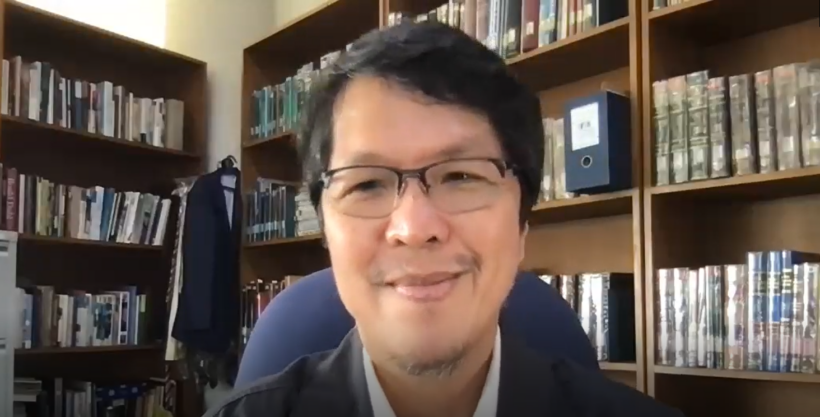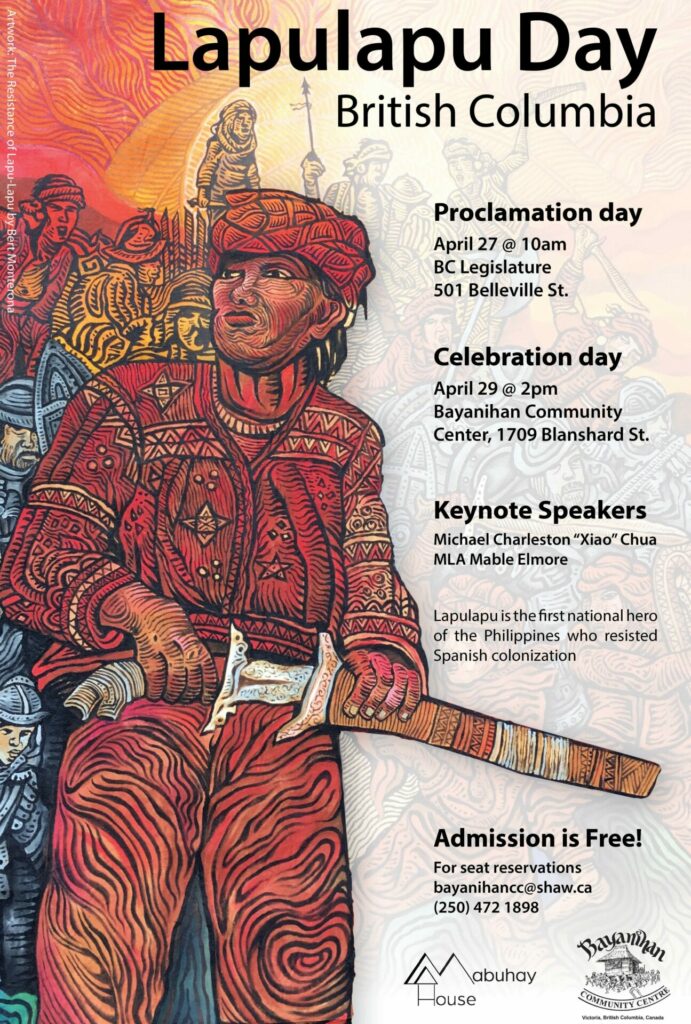by Maria Veronica G. Caparas
The year 2021 marked the Philippines’ quincentennial or 500-year relationship with Spain – a relationship that made the Philippines the capital country of Catholicism in Asia. Through Proclamation No. 1128, then-Philippine President Rodrigo R. Duterte declared April 27 as a special day to commemorate the Filipinos’ Victory at Mactan vis-à-vis the Battle of Mactan between Lapulapu and Magellan in 1521.
Two years later, the BC (British Columbia) Government – through the Office of Parliamentary Secretary (Anti-Racism) MLA Mable Elmore, sponsors a bill with the Legislative Assembly of British Columbia proclaiming April 27 as Lapulapu Day. A group of artists with the Bayanihan Centre in Victoria, BC will stage on April 29 an excerpt of Nicolas B. Pichay’s “Lapulapu: Ang Datu ng Mactan” in support of MLA Elmore’s bill.
How did the Philippines prepare for commemorating the Victory at Mactan on April 27, 2021?
Arsenio “Nick” Lizaso, then President of the Cultural Centre of the Philippines and chair of the National Commission on Culture and the Arts, along with Rene Escalante, Chair of the National Historical Commission of the Philippines (NHCP), were looking for a playwright who could present the eventful native-won battle, and found just the right person for the job: Carlos Palanca Hall of Fame artist, the renowned playwright-cum-lawyer Nicolas “Nick” B. Pichay for whom MLA Elmore has only accolades, “Such a truly Renaissance man!”. And so it is through the analytical and creative lenses of Nicolas B. Pichay that the story about how the Filipinos welcomed the spice-seeking Spaniards (SSSs) on Philippine shores in 1521 that culminated in the Victory at Mactan starts to unfold.

Nick Pichay began his research in January 2021 on what little is known about the Battle of Mactan paragon, Lapulapu (unhyphenated, accented on the second and fourth syllables; the fish, lapu-lapu is hyphenated, accented on the first and third syllables). Nick read Antonio Pigafetta’s travel diaries in Spanish, consulted historians, one of whom is Assistant Professor Michael Charleston “Xiao” Chua of De La Salle University, and analyzed theories surrounding the Mactan victory. With Pigafetta’s diaries written in Spanish too different from the contemporary Spanish that he knows, Nick sought the assistance of Chaz Navarro – archivist at the Ateneo de Manila Library, in decoding Pigafetta’s text.
Pichay’s libretto focuses on the Victory at Mactan, “What we want to commemorate is the first record of somebody saying “No” to a foreign person or entity”. For Pichay, the Battle of Mactan is only a small battle. There was then no nation to defend. Nick saw the opportunity to present in his libretto what the world does not know, effectively challenging the colonizers’ analogy of the world as a virgin to circumnavigate and to conquer while simultaneously upending the global celebration of the circumnavigation of the world deemed important based on a European’s claim of having circumnavigated the world.
The librettist immortalizes the natives’ circumnavigation of the country and of the world through Lapulapu’s character. Lapulapu knows how killing a foreign intruder turns into a small battle amidst larger ones:
Who am I now that I have killed this person?
Nobody will remember me.
I am nobody.
I am like the sand in the sea.
I am just a speck.
If the forces of this king come back to avenge
the death of his soldier,
are we ready to confront them?
In March 2021 or two months after accepting the CCP-NHCP-NCCA appointment, Pichay completed “Lapulapu: Ang Datu ng Mactan”. The musical – streamlined in the pandemic in October 2021, opened Manila’s newly renovated Metropolitan Theatre. It received rave reviews, celebrated Catholicism and the Filipinos’ circumnavigation of the globe, and highlighted the Filipinos’ culture of transaction with strangers, traders, and visitors from Spain.
Pichay’s role as the Philippine Senate’s Director for Legislative Research Service complements the historical significance of his creative work to highlight the country’s role in repudiating the Treaty of Tordesillas of 1494. He takes care of books: the acquisition, the preservation, and the dissemination of books, and does a lot of research regarding the history of legislation, the current status of bills and resolutions that are being processed and discussed in the Senate. Pichay’s role extends beyond geopolitical boundaries, especially in these times of truth-building, rights-assertion, and resource-protection against the tokenisms of the post-neoliberal policy regime and its lip services of truth and reconciliation.
Fernando Magellan’s accidental arrival in one of the 7,110 islands is a consequence of Pope Alexander VI’s issuance of the 1493 Papal Bull. In these decrees, the Pope divided the New World’s resources into two for two spice-needy European countries, Spain and Portugal, to exploit. The King of Portugal did not trust that Magellan could succeed in his planned route to hit the most-prized spices; hence, ignored him. Defector Magellan found favor with the King of Spain who sent him on the expedition.
When Magellan’s ship in a force majeure got caught by the rocks off Homonhon Island due to low tide, the natives offered food to the famished and seasick sailors. Here, Pichay shows the natives of the islands as used to bartering goods with Chinese, Whites, and other traders. Exploring more islands, Magellan and his fellow spice-seeking Spaniards (SSSs) finally arrived on an island. The chieftain, Datu Humabon – perhaps the first colonial-minded native who looked at Magellan as his ally in getting rid of frenemy native, Lapulapu, succumbs to Magellan’s bidding, “If you become the subject of the powerful King, we will protect you from your enemies.” Humabon surrendered to the authority of the King of Spain and allowed himself to be baptized. Magellan was then trying to use Humabon’s island as a port connection to the Moluccas Spice Islands. Humabon, a chief trader, retorts, “You can port on our coastline but you have to pay tribute to me”. This highlights the economic nature of this initial transaction.
History reveals that part of the two camps’ trade agreement is for the natives to be baptized – following the ritual of Humabon’s submission to the King of Spain. When it was time for Lapulapu’s tribe to be baptized, Lapulapu refused. Pichay articulates, “For good or for bad, our projection of nationalism has been Lapulapu. Of course, the Philippines did not exist back then, and Lapulapu could not have thought of the Philippines as we think of the Philippines now. Lapulapu is our figure of nationalism AFTER the fact”.
Pichay ties up important details in Magellan’s expedition. The “riches” in the shipwreck included the image of the Child Jesus. As part of the gift-giving between Magellan and Humabon, Magellan gave this image to the childless Humamay – Humabon’s wife. Humamay gets enamored of this image, holds it and raises it with her hands, and dances. Pichay looks at Humamay’s gesture as “a combination of pagan and Catholic worship. Roman Catholics do not dance with the Santo Niño the way Humamay did. We adopted Roman Catholicism in a different way. Compare the pageantry and the drinking for their gods in an altered state of being with that of the Roman Catholics’ worship that is so solemn”. Records have it that Humamay’s statue image of the Child Jesus got lost and then subsequently re-emerged 150 years later on the island shores. On closer look, the image is that of the Santo Niño de Cebu that Humamay had. Humamay’s dance with the image handed down to the natives of Cebu the Feast of the Santo Niño that is celebrated today as the Sinulog with much dancing a la Humamay’s.
Magellan’s death in the Battle of Mactan rendered his second-in-command travel companion, Juan Sebastian de Elcano, in sole command of the expedition. Upon his return to Spain, Elcano was knighted by the King and given a crest inscribed with, Primus circumdedisti me (You were the first to circumnavigate me). Miguel Lopez de Legazpi then continued the Spanish “discovery” of the Philippines. Legazpi came with friars who “destroyed a lot of indigenous cultures, imposed a belief system that is alien to us, and committed an act of rape, a rampage; they erased our culture that we need to reclaim. The islands were populated by tribes of many faiths. There were animists. Our islands were inhabited by many groups. We had Muslim people. We had animists who believed in many gods; we had a culture before the Spaniards came,” Nick asserts. Pichay ends his play in the pandemic Covid-19 with the nurse, May Parsons – a UK-based Filipina, who administered the first Covid-19 vaccine, emphatically showing how Filipinos, in their many countenances, continue to circumnavigate the world.
Nicolas B. Pichay’s prayerful desire? That the publication of “Lapulapu, Ang Datu ng Mactan” into an educational material and its dissemination among young learners be a major part of MLA Elmore’s bill. This will facilitate the dissemination of information about the country’s circumnavigation of herself before 1521 and the Philippines’ continuing circumnavigation of the world in pandemic 2021 and beyond. Pichay’s libretto and script is written in two Philippine major languages, Cebuano and Tagalog, with a touch of Spanish, and of the two official languages of the Philippines, English and Filipino.
Footnotes:
1. What defines indigeneity?
A broad, working definition of Indigeneity is that it is a quality of a person’s and a group’s identity that links them to specific places with knowledge of and respect for original ways. Although it is not a catch-all word, many Indigenous peoples (internationally speaking as well) are increasingly preferring this word as a source of solidarity with other Indigenous peoples, and again – it recognizes the significance of LAND to these cultures, identities, and histories.
2. The Battle of Mactan (Cebuano: Gubat sa Mactan; Filipino: Labanan sa Mactan; Spanish: Batalla de Mactán) was a fierce clash fought in the archipelago of the Philippines on April 27, 1521. The warriors of Lapulapu, one of the Datus of Mactan, overpowered and defeated a Spanish force fighting for Rajah Humabon of Cebu under the command of Portuguese explorer Ferdinand Magellan, who was killed in the battle. The outcome of the battle resulted in the departure of the Spanish crew from the archipelago of the Philippines. Magellan was succeeded by Juan Sebastián Elcano as commander of the expedition. After Humabon’s betrayal, he ordered an immediate departure. Elcano and his fleet sailed west. They reached Spain in 1522, completing the first circumnavigation of the world.
About the writer:
 Maria Veronica G. Caparas. MVGC’s initial collaboration with Nick Pichay is in Dulaang Unibersidad ng Pilipinas’ 1980s production of Bertolt Brecht’s Threepenny Opera under Professor Antonio O. Mabesa’s artistic direction.
Maria Veronica G. Caparas. MVGC’s initial collaboration with Nick Pichay is in Dulaang Unibersidad ng Pilipinas’ 1980s production of Bertolt Brecht’s Threepenny Opera under Professor Antonio O. Mabesa’s artistic direction.










